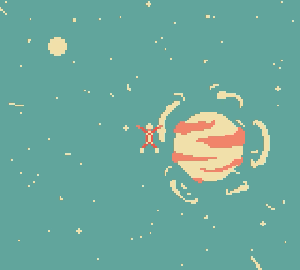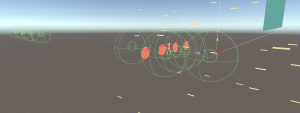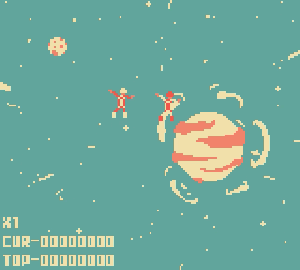Last week I took part in the fifth GBJAM. A popular game jam that pays homage to Game Boy games but allows for modern sensibilities to creep in. Initially I had no plans to take part but a developer on the newly formed Icelandic Gaming Industry Slack mentioned it. Soon I and a handful of others decided to join in. The basic format gives you ten days to make a game. There are two significant constraints, a four color palette and a ‘pixel resolution’ restriction of 160×144. After the ten days are up competitors then rate one another’s games.
In the end I spent around 16 hours making Void-Dogs and finished in 82nd place out of 402 entries which I’m pretty pleased with!
Motivation
I’ve been working pretty much continuously for 12 years making games and playful things. My emotional makeup is such that I really invest in the thing I’m making at any one time so I find it hard to juggle multiple creative projects at once. I don’t have the headspace for it. As such I’ve found it hard to work on sideprojects. I’ve made things during both my recent paternity leaves as good contiguous blocks of “free” time. Development time was “luckily provided” thanks to Autodesk laying a bunch of us off in August. Since then I’ve been working for two hours a day on a small game called What Now Earthman?. But that is still a big project I won’t complete for the foreseeable future. So I was already motivated to make something smaller in scope. The GBJAM popped up as a good enough answer.
Development
Void-Dogs took sixteen hours in total to finish. I started a day late but I don’t think that made any real difference. I started off working two hours per day but eventually did a little more from Wednesday onwards. In general it was quite a relaxed affair tucked around child care. Void-Dogs was made in Unity which is probably my favourite engine for making a myriad of games and prototypes quickly. I task tracked with lists on graph paper. I wrote all the code and made all the art and SFX by myself but found some Creative Commons music to use as a soundtrack. My main source of inspiration was the game Space Harrier but I wanted something that involved a little less spraying bullets directly forward. After a bit of brainstorming I came up with the concept of “skydiving in space” and went off to work! You can download and play the result here.
The most interesting technical challenge was creating the sense of depth and motion with a limited resolution. In the end I actually opted to use a perspective camera and Unity’s particle system to create some ‘dust’ that gives the impression of hurtling through space. Another important addition was the use of a ‘sine wave’ shake script I wrote some time ago. I initially intended it for cameras but it works just as well applied to other objects and captures that never still motion of a skydiver falling at terminal velocity, not realistic but it feels good.
All the asteroids and players are positioned in 3D space with one unit equal to one pixel. This let me simply calculate the depth into the camera where I would get pixel perfect rendering. I initially tried rendering the sprites moving through space directly but the resolution makes for ugly pixel artifacts as sprite pixels pop in and out across real pixel boundaries. This wasn’t an unexpected problem, it’s part of the reason you see games like Space Harrier do 3D by changing sprite sizes (also hardware optimised sprite rendering). Moving to this approach required a bunch of labor to make art assets but is much better visually and thematically. In the end all the sprites sit on the ‘focal plane’ and are represented by colliders and transforms moving through 3D space. I then switch sprite depending on depth and reposition the sprite correctly on the focal plane to simulate the perspective of the camera. Everything is then snapped to the nearest pixel to allow for fluid motion without pixel artifacts.
Unlike the above image the colliders actually ended up being boxes and pushed back behind the sprite. It seems obvious in hindsight but it felt all sorts of wrong with the collision as it was above. The inner collider is for the asteroid itself and the outer collider is the zone for the proximity bonus.
What went well?
Art
My art drew a lot of positive comment and was a reasonably highly scored feature of the game placing 54th in that category. As someone who only started making game art again when I went on paternity leave this felt pretty good. Even more so as I hadn’t made any pixel art or pixel art animations for games before. A lot of this I credit to time spent sitting down cranking out bad vector art for What Now Earthman? it’s getting better but I learnt a lot in the three months I’ve been drawing semi-regularly. I’ve got a much stronger understanding of color theory, shading and other basics than I ever did before. On top of which I learnt that good art takes time (duh!) and not to try to rush through making something. Even a game as simple as Void-Dogs contains a surprising amount of art and it took perhaps half my development time to make it all. Including remaking art for the Itch.io page.
Gameplay
I ended up with my highest placement ranked 48th for the gameplay. I’m pretty pleased with the gameplay mechanics I added and how they work together. There are three essential layers. First the asteroids arriving in patterns forcing the player to dodge through waves of obstacles. Second the player scores more points for flying in proximity to the asteroids adding a risk-reward mechanic for people that find the dodging gameplay simple adding a layer of mastery. Third other divers will arrive next to you and fight for a short amount of time, the only means of killing them is to hit them with a laser bolt that stuns them and have the splat into an asteroid. This sets up a complex timing problem for the player to solve whilst dodging asteroids and incoming laser fire. These were strong fundamentals to build a fun game on and the feedback I’ve received seems to agree.
The AI itself is a simple steering behavior that has a target, avoids the player and asteroids then occasionally fires towards the player. It’s surprisingly good at hitting you!
Scope
I carefully managed my scope throughout the project. Mostly in the classic manner of frontloading the risky items I hadn’t done before. I also kept a Kanbanish working list also meant I could rearrange and remove tasks easily as I went along. I pretty comfortably worked through to the weekend when the days are taken up by looking after a boisterous three year old and two month old! Then I managed to snatch enough time to pull things together and enter my submission with quite a bit of time to spare even if it wasn’t time I couldn’t use on my entry!
Architecture
Architecture in a jam game? I saved a whole heap of time by doing simple things like separating the component implementing the actions of the diver from the component that controls how those actions are used. Both the player and the AI use the same actions. Similarly the components for sprite scaling and screen positioning were written to be easily shared and meant it was trivial to add in scaling for the enemy entering the game. I have a simple Events system I wrote for WNE that drives a lot of the UI update and game flow between objects that should be decoupled as much as possible. All my bullets and asteroids live in object pools local to where they are used and are drawn from them as needed. Finally the stage design is done within a coroutine and a library of helper functions so it looks a little like this:
Bullseye(); Grid(); yield return new WaitForSeconds(2.0f); Cross(); yield return new WaitForSeconds(2.0f); Bullseye(); XThru(); yield return new WaitForSeconds(2.0f); Grid(); yield return new WaitForSeconds(4.0f); //fight AIEnter(); yield return new WaitForSeconds(2.0f); BigSpiral(); yield return new WaitForSeconds(16.0f);
I’d attribute finishing this game at all to keeping on top of the code design as I went. Then hacking madly at the end! But keeping things neat made the hacks easier to implement.
What went badly?
Audio
I’ve done precious little audio work and it really shows in Void-Dogs. My two lowest ratings were for Sound (#100) and Gameboy Feel (#177). My music selection was a big contributor to the latter, it was the best Creative Commons licensed track I could find which didn’t really suit the Game Boy era and slightly bends the rules on Audio as it wasn’t an asset made for the jam. SFX were made using BFXR and whilst I think they are serviceable as placeholders they don’t really hold together or excite. I think rather than taking on yet another task were I to do this again I’d try to pair up with someone that knows what they are doing. Although I’m trying to get a basic handle on how to make better SFX and where to even start with music just to understand the processes.
Stage Design
I was pretty sure at the start of the jam that I wanted to have hand crafted stages rather than trying to create a procedural generation algorithm in such a short space of time. In the end I only had time to make one stage and iterate on it a little bit after some playtest feedback. Finding fun sequences and building them out whilst also trying to deal with the problems with perspective and the screen getting messy was really challenging! To be frank the result is a mish-mash of ideas in a steady progression punctuated with ‘clone’ fights. One of my biggest missed opportunities was not front loading a clone fight. I think many people probably played the game without reaching the first one! My goal was to have a series of escalating stages that lead the player in but this wasn’t really realised.
Scope
Could I have done better in the time I had? Perhaps? I look back through my notes trying to find places I wasted time and it’s really hard to say. I think I could have picked either the obstacle dodging or the clone fighting as the focus and doing both was perhaps unnecessary for a jam. Though I do think they compliment one another and was keen to push outside of the shooter norms. Mostly I think I wish I had more free time to put into it or had planned on taking part and done some prep work.
The single biggest thing I didn’t budget time for was setting up the Itch.io page which took a lot longer than I thought. Presentation matters in terms of first impressions and to get eyes on your game. Annoyingly the Jam entry page misses most of the instructions and theming which was an issue as I’d included the instructions on the site proper. Hopefully most people clicked through to give it a read but players didn’t have too.
Lessons for future Jams?
This was fun and I’d like to do it again when I have some free time, in particular I think the constraints made for a really fun jam format. The biggest takeaway I have is to team up with other people to cover the bits I’m rubbish at. I’d also like to try my hand at just working on the art and design whilst leaving the lion’s share of the programming to someone else. I like the art process, it’s not what I do in my day job and jams feel like a good venue to practice. Then the usual things for game development in general were really validated for me; have a small scope, make something you know how to do, get the game up and running quickly, playtest and iterate.








